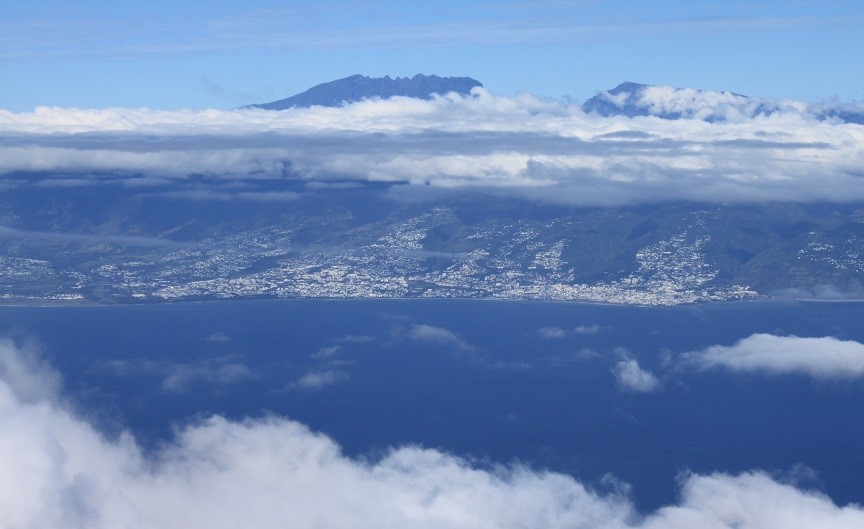
September 3, 2019, by lzzeb
Island Biology 2019
A blog by Michela Mariani and Richard Field
Only few months after moving to Nottingham from Australia, Michela was heading back to the Southern Hemisphere on a memorable conference trip. For Richard, who long ago lived on the equator, it has been much longer since he last crossed that important geographic line. We both attended the 3rd Island Biology Conference on the amazing tropical island of La Réunion, a French Département in the Indian Ocean, about 700 km east of Madagascar. The photo shows a view of the island from the plane; the conference itself was in Saint Denis, the urban area visible in the middle of the picture.
Two of the School of Geography’s PhD students were also there, presenting their PhD research on islands: Vanessa Cutts on the traits of Canary Island plants and Emma Higgins on microhabitat use by Honduran island lizards. The Island Biology conference is held every 3 years and attracts scientists from all over the world. The main fields of research represented to date have been ecology, evolution, conservation and biogeography of terrestrial and marine biotas.
La Réunion is definitely one of the best locations either of us has been to attend an academic conference, competing in Michela’s case with Hawaii, New Zealand and Patagonia, and in Richard’s with Bali, Tenerife, Azores and Merida (Mexico)! The island is of volcanic origin, quite large for an oceanic island at 2,512 km² in area, and hosts stunning rugged mountains (see landscape photo of the island’s interior), shaped by both erosion from the abundant rainfall and repeated caldera collapses, and a magical coastline dotted with black beaches. It has big waves (Please click the link to play the video) https://mediaspace.nottingham.ac.uk/id/1_496xiff3?width=400&height=285&playerId=13724441 but also the world’s worst coast for shark attacks, so surfing has all but ceased, and swimming in the sea is largely restricted to protected coral lagoons.
The island is quite famous for hosting one of the most active volcanoes in the world, Piton de la Fournaise, part of the UNESCO World Heritage site (designated in 2010) that covers much of the interior of the island. It erupted on 29th July 2019, just 15 days after Richard climbed it and took the photo of its crater shown here (for scale is Prof. KC Burns of Victoria University of Wellington, New Zealand – author of a 2019 book on island plant evolution and one of two potential hosts of the next Island Biology meeting). The highest peak, part of the extinct volcano Piton des Neiges (shown here at sunset, sitting above a cloud sea), reaches 3,070m above sea-level, making the island one of the highest oceanic islands on the planet.
La Réunion is also a hotspot for endemic plants and animals; 72% of the ~2,000 flowering plant species are endemic. About 30% of the native flora is currently endangered. Over the last three decades, La Réunion has experienced rapid land-use changes and intensification of human activities, linked to population growth and economic development, which are currently affecting biogeographical patterns on the island.
We both feel very lucky to have been able to attend this conference, and this was made feasible by support from the School of Geography. Michela used the opportunity to catch up with many of her colleagues from the land Down Under, who also attended the conference. Similarly, Richard is a part of several initiatives focused on island biogeography, and met up with many of the scientists involved, advancing ongoing projects and planning future ones. We both appreciated the high quality of the science presented at the conference, and we have made new connections, and new plans for future collaborations.
Michela’s talk (photos below) was entitled ‘Living on the edge: the effects of long-term climate change and fire activity on the remnant cool temperate rainforests of Tasmania (Australia)’. She specifically dealt with the impact of past climatic change fire regimes on remnant populations of montane rainforests in the island of Tasmania over the Holocene epoch (last ~12,000 years).
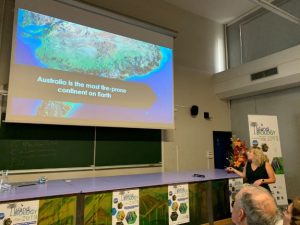
Michela captured during her talk on the last day of conference (ph. Simon Haberle) and title slide above.
Richard’s talk, ‘Isolation by elevation promotes speciation on islands globally’ had more of a theoretical focus, reporting strong support from a global study of islands for a hypothesis about evolution that he has been developing with colleagues (mostly from Germany). This research takes advantage of the natural experiment that tall oceanic islands constitute: replicated elevational gradients, and lots of endemic species on each.
One of the best aspects of the Island Biology 2019 conference was the vast choice of field trips available, from coast to summit, exploring this magical biodiversity hotspot. Unusually, the main conference field trips took place during a ‘rest day’ in the middle of the conference (rather than before or after), with two days of talks and posters before, and two after. Two pictures from the heart of the island are shown, which Michela took during the excursion.
Just because we like numbers and facts, here are some interesting ones we have learned about the island:
– Parts of La Réunion have exceptionally high rainfall: the wettest part, on the Piton de la Fournaise volcano, which catches the moisture from the SE trade winds, averages 12,000 mm/yr (the record year was ~18,000 mm). Even more impressive are the intense downpours, with La Réunion holding the official world record for rain in a 24-hour period (1825 mm at the site ‘Foc-Foc’ on January 7–8, 1966) and the unofficial records for both 24-hour and 48-hour periods (1870 mm at Cilaos in 1952 and 3000.5 mm at ‘Baril 1600’ in 1993, respectively). However, in the NW of the island, where we were, it is much drier and we mostly had sunshine.
-The population of the island increased from ~598,000 in 1990 to ~867,000 in 2019.
-The ethnic mix of the island’s inhabitants is remarkably diverse, with relatively large populations of Malagasy, Indian and Chinese origin. Many hold the La Réunion up as an example of a successful ethnic melting pot. While French is the official language, many of the islanders speak Réunion Creole, and Creole cuisine is very common in the restaurants.
-La RéunionNational Park covers about 42% of the island, concentrated in the mountainous interior.
The next Island Biology conference venue, for July 2022, is currently being voted on. The two options Wellington in New Zealand (quite cold and windy in the austral winter) or Palma de Mallorca (hot and sunny in the boreal summer). It will be a great conference either way; we can’t wait!
No comments yet, fill out a comment to be the first

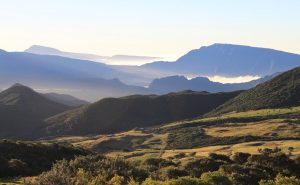
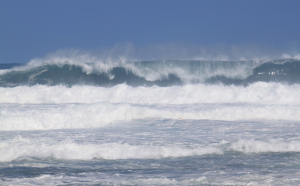
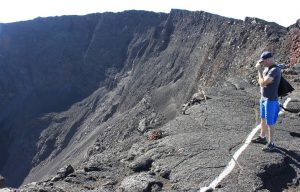
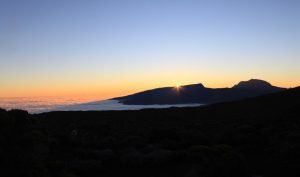
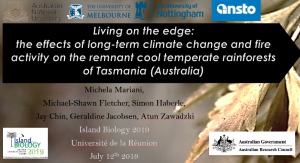
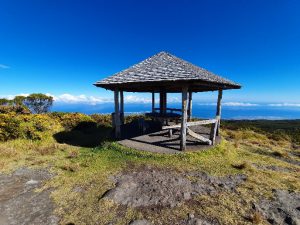
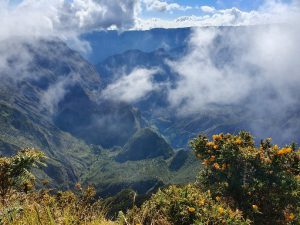
Leave a Reply